Report on Influencing and Decision-Making in Organizations
VerifiedAdded on 2021/06/18
|10
|2628
|20
Report
AI Summary
This report provides a comprehensive analysis of group decision-making, exploring various methods such as consensus, voting, and the Delphi method. It examines the importance of effective group communication, including top-down interactions and electronic methods, and highlights the benefits of team cohesion and engagement. The report delves into performance-based decision-making, emphasizing the use of business data and data collection through computerization. It also covers the stages of group development, including forming, storming, norming, and performing, as well as the ethical dimensions of decision-making, emphasizing the need to consider both legality and societal impact. Furthermore, the report discusses the significance of workplace trust and security, and addresses the issues of fear and silence in group behaviour, including the concept of the "spiral of silence." This report offers valuable insights into the dynamics of group behaviour and decision-making in organizational settings.

Influencing and making decision
Student Name
University Name
Student Name
University Name
Paraphrase This Document
Need a fresh take? Get an instant paraphrase of this document with our AI Paraphraser
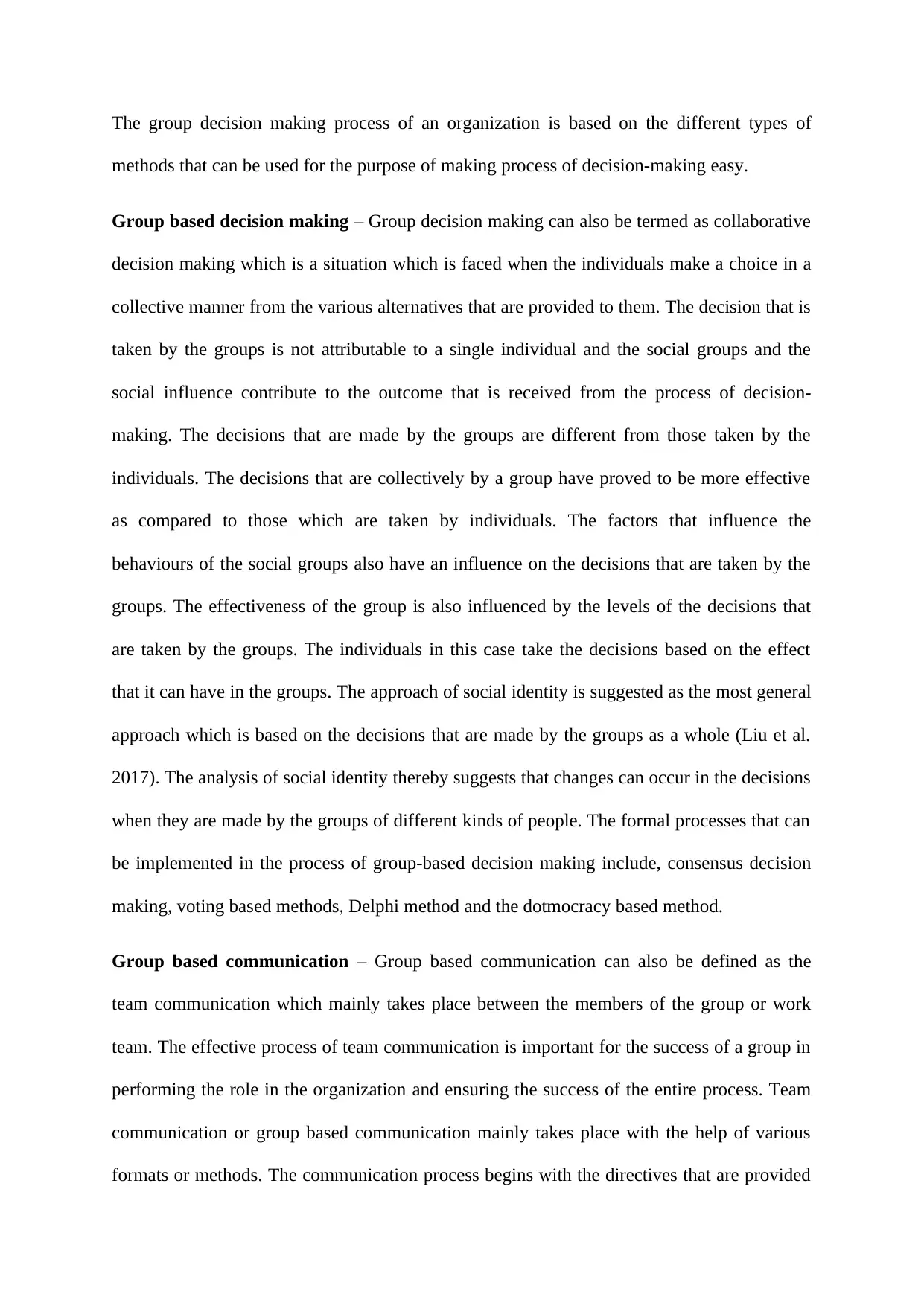
The group decision making process of an organization is based on the different types of
methods that can be used for the purpose of making process of decision-making easy.
Group based decision making – Group decision making can also be termed as collaborative
decision making which is a situation which is faced when the individuals make a choice in a
collective manner from the various alternatives that are provided to them. The decision that is
taken by the groups is not attributable to a single individual and the social groups and the
social influence contribute to the outcome that is received from the process of decision-
making. The decisions that are made by the groups are different from those taken by the
individuals. The decisions that are collectively by a group have proved to be more effective
as compared to those which are taken by individuals. The factors that influence the
behaviours of the social groups also have an influence on the decisions that are taken by the
groups. The effectiveness of the group is also influenced by the levels of the decisions that
are taken by the groups. The individuals in this case take the decisions based on the effect
that it can have in the groups. The approach of social identity is suggested as the most general
approach which is based on the decisions that are made by the groups as a whole (Liu et al.
2017). The analysis of social identity thereby suggests that changes can occur in the decisions
when they are made by the groups of different kinds of people. The formal processes that can
be implemented in the process of group-based decision making include, consensus decision
making, voting based methods, Delphi method and the dotmocracy based method.
Group based communication – Group based communication can also be defined as the
team communication which mainly takes place between the members of the group or work
team. The effective process of team communication is important for the success of a group in
performing the role in the organization and ensuring the success of the entire process. Team
communication or group based communication mainly takes place with the help of various
formats or methods. The communication process begins with the directives that are provided
methods that can be used for the purpose of making process of decision-making easy.
Group based decision making – Group decision making can also be termed as collaborative
decision making which is a situation which is faced when the individuals make a choice in a
collective manner from the various alternatives that are provided to them. The decision that is
taken by the groups is not attributable to a single individual and the social groups and the
social influence contribute to the outcome that is received from the process of decision-
making. The decisions that are made by the groups are different from those taken by the
individuals. The decisions that are collectively by a group have proved to be more effective
as compared to those which are taken by individuals. The factors that influence the
behaviours of the social groups also have an influence on the decisions that are taken by the
groups. The effectiveness of the group is also influenced by the levels of the decisions that
are taken by the groups. The individuals in this case take the decisions based on the effect
that it can have in the groups. The approach of social identity is suggested as the most general
approach which is based on the decisions that are made by the groups as a whole (Liu et al.
2017). The analysis of social identity thereby suggests that changes can occur in the decisions
when they are made by the groups of different kinds of people. The formal processes that can
be implemented in the process of group-based decision making include, consensus decision
making, voting based methods, Delphi method and the dotmocracy based method.
Group based communication – Group based communication can also be defined as the
team communication which mainly takes place between the members of the group or work
team. The effective process of team communication is important for the success of a group in
performing the role in the organization and ensuring the success of the entire process. Team
communication or group based communication mainly takes place with the help of various
formats or methods. The communication process begins with the directives that are provided

by the company and the task assignments. The assignments thereby involve top-down
interactions between the members of the groups which are formed within the organizations.
The groups can also share the information with the help of discussions by paper
documentation and the electronic methods (Power, Sharda and Burstein 2015). For example,
in the customer service setting, the accounts of the customers contain all the data and the
reports based on the calls, which can be seen by the members of the service team so that a
decision can be made. The major benefits that are provided by the process of team
communication include, cohesion between the members of the group and identity that is
gained by them. Effective group based communication helps in increasing the engagement
levels among the team members. The regular interaction between the members of the group
enables the high levels of engagement with the various work processes (Palomares, Martinez
and Herrera 2014).
Performance based decision making – The process of performance based decision making
in the business involves the analysis of the business data before the strategies or the actions
can be formulated. This process further involves the understanding of the strengths and the
weaknesses of the organization so that the confidence levels can be increased with the
strategies that are finally developed. The performance based decisions are thereby made by
changing the staff levels and developing a new line of products so that the performance of the
organizations can be improved The data that is available within the business helps in the
process of performance based decision making. The computerization of the organizational
processes can also help in the collection of extensive data by the companies. This further
helps in the decision making process of the organizations (Raes et al. 2015).
Group forming – The development of functional groups is a common process within the
various organizations. The groups then supervised by the managers or the supervisors so that
the effectiveness of the members can be increased. The process of group development
interactions between the members of the groups which are formed within the organizations.
The groups can also share the information with the help of discussions by paper
documentation and the electronic methods (Power, Sharda and Burstein 2015). For example,
in the customer service setting, the accounts of the customers contain all the data and the
reports based on the calls, which can be seen by the members of the service team so that a
decision can be made. The major benefits that are provided by the process of team
communication include, cohesion between the members of the group and identity that is
gained by them. Effective group based communication helps in increasing the engagement
levels among the team members. The regular interaction between the members of the group
enables the high levels of engagement with the various work processes (Palomares, Martinez
and Herrera 2014).
Performance based decision making – The process of performance based decision making
in the business involves the analysis of the business data before the strategies or the actions
can be formulated. This process further involves the understanding of the strengths and the
weaknesses of the organization so that the confidence levels can be increased with the
strategies that are finally developed. The performance based decisions are thereby made by
changing the staff levels and developing a new line of products so that the performance of the
organizations can be improved The data that is available within the business helps in the
process of performance based decision making. The computerization of the organizational
processes can also help in the collection of extensive data by the companies. This further
helps in the decision making process of the organizations (Raes et al. 2015).
Group forming – The development of functional groups is a common process within the
various organizations. The groups then supervised by the managers or the supervisors so that
the effectiveness of the members can be increased. The process of group development
⊘ This is a preview!⊘
Do you want full access?
Subscribe today to unlock all pages.

Trusted by 1+ million students worldwide
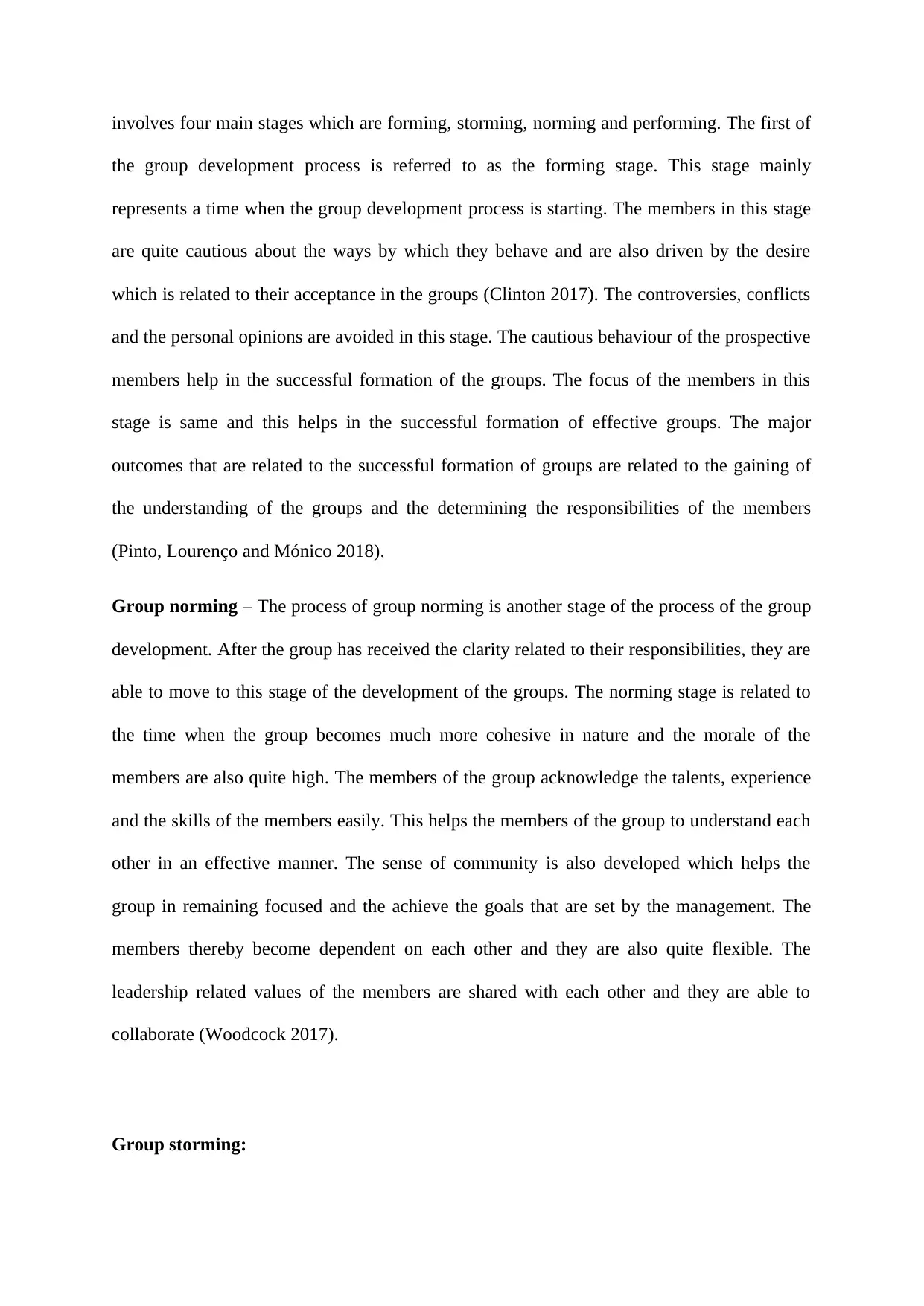
involves four main stages which are forming, storming, norming and performing. The first of
the group development process is referred to as the forming stage. This stage mainly
represents a time when the group development process is starting. The members in this stage
are quite cautious about the ways by which they behave and are also driven by the desire
which is related to their acceptance in the groups (Clinton 2017). The controversies, conflicts
and the personal opinions are avoided in this stage. The cautious behaviour of the prospective
members help in the successful formation of the groups. The focus of the members in this
stage is same and this helps in the successful formation of effective groups. The major
outcomes that are related to the successful formation of groups are related to the gaining of
the understanding of the groups and the determining the responsibilities of the members
(Pinto, Lourenço and Mónico 2018).
Group norming – The process of group norming is another stage of the process of the group
development. After the group has received the clarity related to their responsibilities, they are
able to move to this stage of the development of the groups. The norming stage is related to
the time when the group becomes much more cohesive in nature and the morale of the
members are also quite high. The members of the group acknowledge the talents, experience
and the skills of the members easily. This helps the members of the group to understand each
other in an effective manner. The sense of community is also developed which helps the
group in remaining focused and the achieve the goals that are set by the management. The
members thereby become dependent on each other and they are also quite flexible. The
leadership related values of the members are shared with each other and they are able to
collaborate (Woodcock 2017).
Group storming:
the group development process is referred to as the forming stage. This stage mainly
represents a time when the group development process is starting. The members in this stage
are quite cautious about the ways by which they behave and are also driven by the desire
which is related to their acceptance in the groups (Clinton 2017). The controversies, conflicts
and the personal opinions are avoided in this stage. The cautious behaviour of the prospective
members help in the successful formation of the groups. The focus of the members in this
stage is same and this helps in the successful formation of effective groups. The major
outcomes that are related to the successful formation of groups are related to the gaining of
the understanding of the groups and the determining the responsibilities of the members
(Pinto, Lourenço and Mónico 2018).
Group norming – The process of group norming is another stage of the process of the group
development. After the group has received the clarity related to their responsibilities, they are
able to move to this stage of the development of the groups. The norming stage is related to
the time when the group becomes much more cohesive in nature and the morale of the
members are also quite high. The members of the group acknowledge the talents, experience
and the skills of the members easily. This helps the members of the group to understand each
other in an effective manner. The sense of community is also developed which helps the
group in remaining focused and the achieve the goals that are set by the management. The
members thereby become dependent on each other and they are also quite flexible. The
leadership related values of the members are shared with each other and they are able to
collaborate (Woodcock 2017).
Group storming:
Paraphrase This Document
Need a fresh take? Get an instant paraphrase of this document with our AI Paraphraser
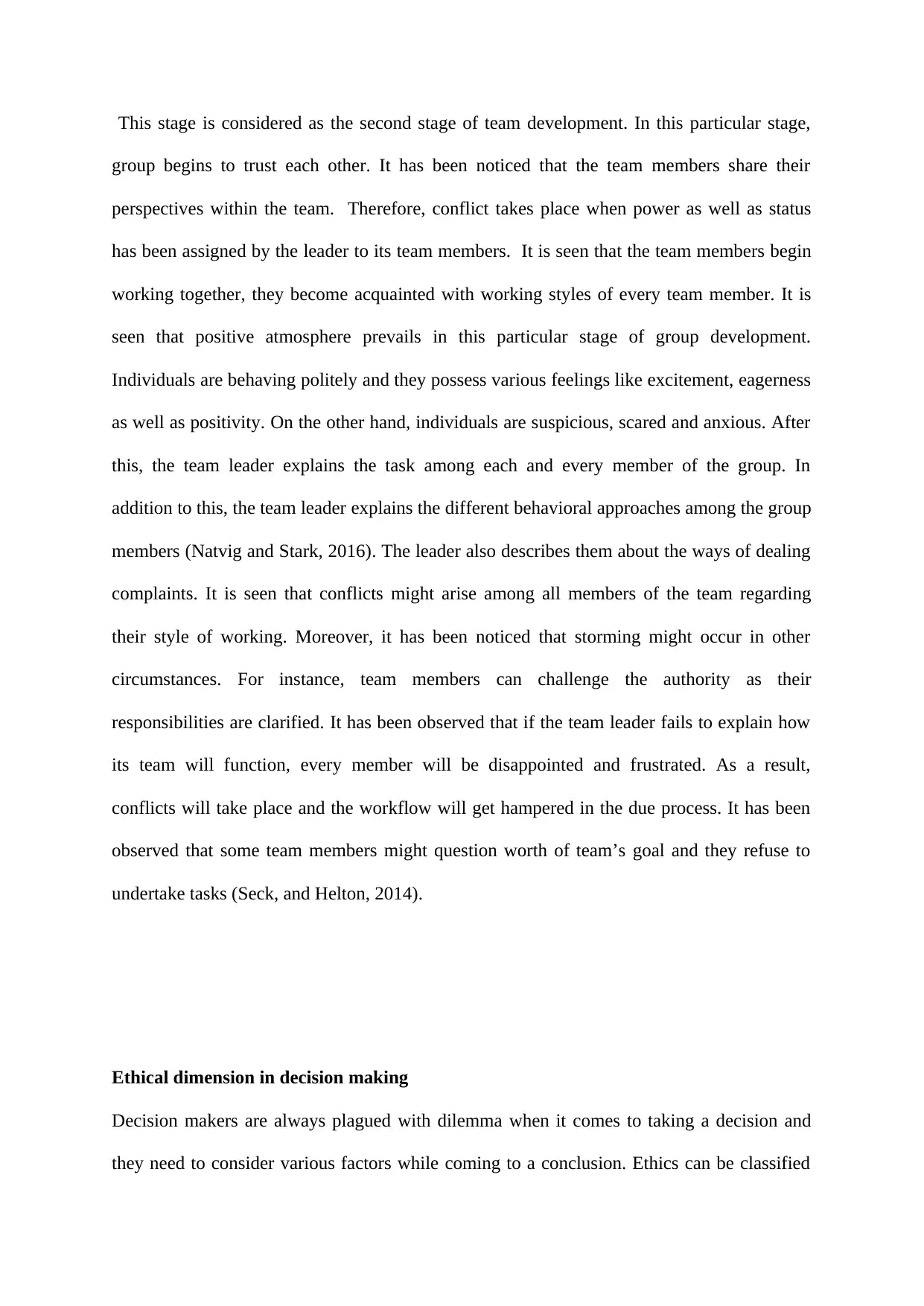
This stage is considered as the second stage of team development. In this particular stage,
group begins to trust each other. It has been noticed that the team members share their
perspectives within the team. Therefore, conflict takes place when power as well as status
has been assigned by the leader to its team members. It is seen that the team members begin
working together, they become acquainted with working styles of every team member. It is
seen that positive atmosphere prevails in this particular stage of group development.
Individuals are behaving politely and they possess various feelings like excitement, eagerness
as well as positivity. On the other hand, individuals are suspicious, scared and anxious. After
this, the team leader explains the task among each and every member of the group. In
addition to this, the team leader explains the different behavioral approaches among the group
members (Natvig and Stark, 2016). The leader also describes them about the ways of dealing
complaints. It is seen that conflicts might arise among all members of the team regarding
their style of working. Moreover, it has been noticed that storming might occur in other
circumstances. For instance, team members can challenge the authority as their
responsibilities are clarified. It has been observed that if the team leader fails to explain how
its team will function, every member will be disappointed and frustrated. As a result,
conflicts will take place and the workflow will get hampered in the due process. It has been
observed that some team members might question worth of team’s goal and they refuse to
undertake tasks (Seck, and Helton, 2014).
Ethical dimension in decision making
Decision makers are always plagued with dilemma when it comes to taking a decision and
they need to consider various factors while coming to a conclusion. Ethics can be classified
group begins to trust each other. It has been noticed that the team members share their
perspectives within the team. Therefore, conflict takes place when power as well as status
has been assigned by the leader to its team members. It is seen that the team members begin
working together, they become acquainted with working styles of every team member. It is
seen that positive atmosphere prevails in this particular stage of group development.
Individuals are behaving politely and they possess various feelings like excitement, eagerness
as well as positivity. On the other hand, individuals are suspicious, scared and anxious. After
this, the team leader explains the task among each and every member of the group. In
addition to this, the team leader explains the different behavioral approaches among the group
members (Natvig and Stark, 2016). The leader also describes them about the ways of dealing
complaints. It is seen that conflicts might arise among all members of the team regarding
their style of working. Moreover, it has been noticed that storming might occur in other
circumstances. For instance, team members can challenge the authority as their
responsibilities are clarified. It has been observed that if the team leader fails to explain how
its team will function, every member will be disappointed and frustrated. As a result,
conflicts will take place and the workflow will get hampered in the due process. It has been
observed that some team members might question worth of team’s goal and they refuse to
undertake tasks (Seck, and Helton, 2014).
Ethical dimension in decision making
Decision makers are always plagued with dilemma when it comes to taking a decision and
they need to consider various factors while coming to a conclusion. Ethics can be classified
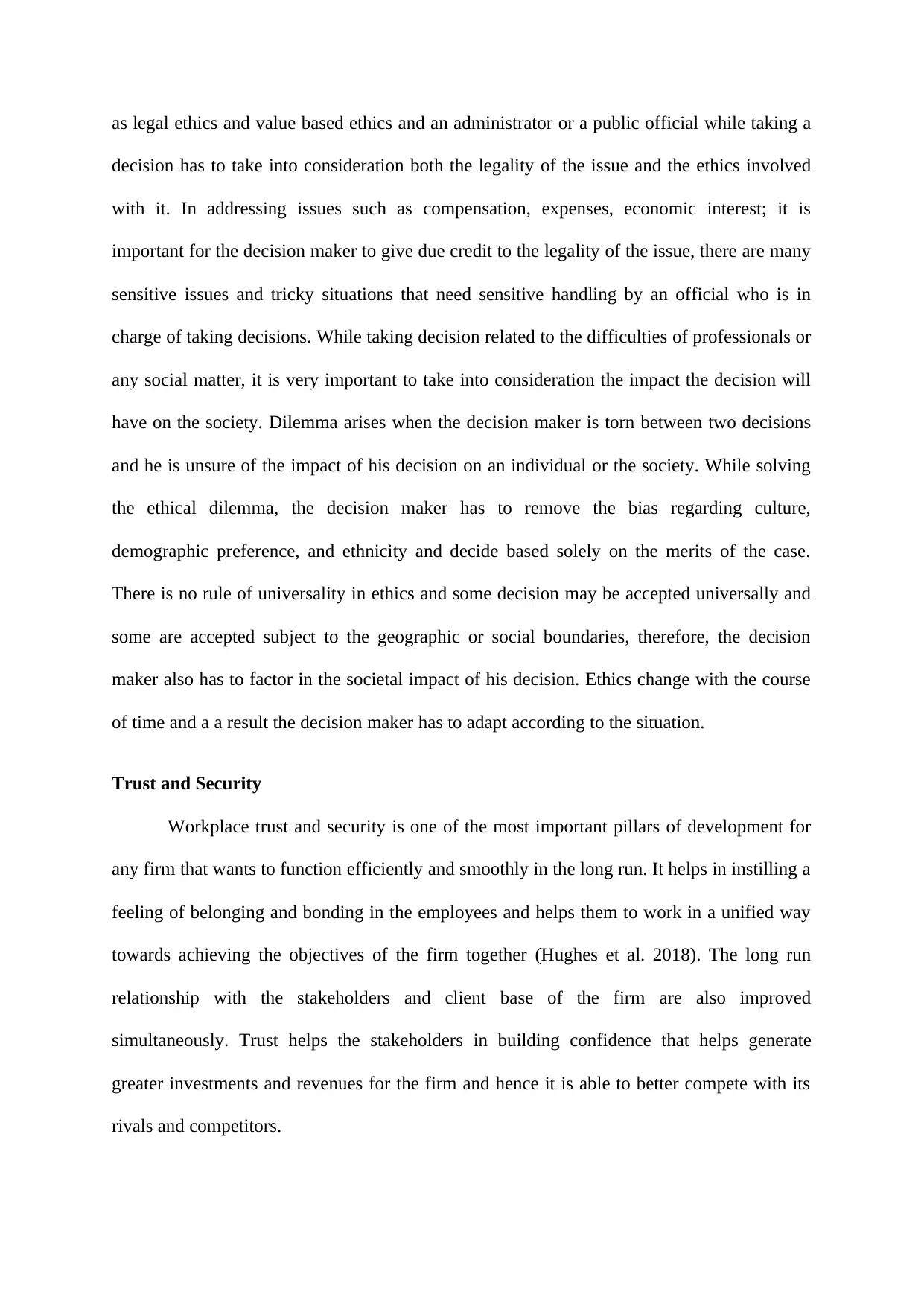
as legal ethics and value based ethics and an administrator or a public official while taking a
decision has to take into consideration both the legality of the issue and the ethics involved
with it. In addressing issues such as compensation, expenses, economic interest; it is
important for the decision maker to give due credit to the legality of the issue, there are many
sensitive issues and tricky situations that need sensitive handling by an official who is in
charge of taking decisions. While taking decision related to the difficulties of professionals or
any social matter, it is very important to take into consideration the impact the decision will
have on the society. Dilemma arises when the decision maker is torn between two decisions
and he is unsure of the impact of his decision on an individual or the society. While solving
the ethical dilemma, the decision maker has to remove the bias regarding culture,
demographic preference, and ethnicity and decide based solely on the merits of the case.
There is no rule of universality in ethics and some decision may be accepted universally and
some are accepted subject to the geographic or social boundaries, therefore, the decision
maker also has to factor in the societal impact of his decision. Ethics change with the course
of time and a a result the decision maker has to adapt according to the situation.
Trust and Security
Workplace trust and security is one of the most important pillars of development for
any firm that wants to function efficiently and smoothly in the long run. It helps in instilling a
feeling of belonging and bonding in the employees and helps them to work in a unified way
towards achieving the objectives of the firm together (Hughes et al. 2018). The long run
relationship with the stakeholders and client base of the firm are also improved
simultaneously. Trust helps the stakeholders in building confidence that helps generate
greater investments and revenues for the firm and hence it is able to better compete with its
rivals and competitors.
decision has to take into consideration both the legality of the issue and the ethics involved
with it. In addressing issues such as compensation, expenses, economic interest; it is
important for the decision maker to give due credit to the legality of the issue, there are many
sensitive issues and tricky situations that need sensitive handling by an official who is in
charge of taking decisions. While taking decision related to the difficulties of professionals or
any social matter, it is very important to take into consideration the impact the decision will
have on the society. Dilemma arises when the decision maker is torn between two decisions
and he is unsure of the impact of his decision on an individual or the society. While solving
the ethical dilemma, the decision maker has to remove the bias regarding culture,
demographic preference, and ethnicity and decide based solely on the merits of the case.
There is no rule of universality in ethics and some decision may be accepted universally and
some are accepted subject to the geographic or social boundaries, therefore, the decision
maker also has to factor in the societal impact of his decision. Ethics change with the course
of time and a a result the decision maker has to adapt according to the situation.
Trust and Security
Workplace trust and security is one of the most important pillars of development for
any firm that wants to function efficiently and smoothly in the long run. It helps in instilling a
feeling of belonging and bonding in the employees and helps them to work in a unified way
towards achieving the objectives of the firm together (Hughes et al. 2018). The long run
relationship with the stakeholders and client base of the firm are also improved
simultaneously. Trust helps the stakeholders in building confidence that helps generate
greater investments and revenues for the firm and hence it is able to better compete with its
rivals and competitors.
⊘ This is a preview!⊘
Do you want full access?
Subscribe today to unlock all pages.

Trusted by 1+ million students worldwide
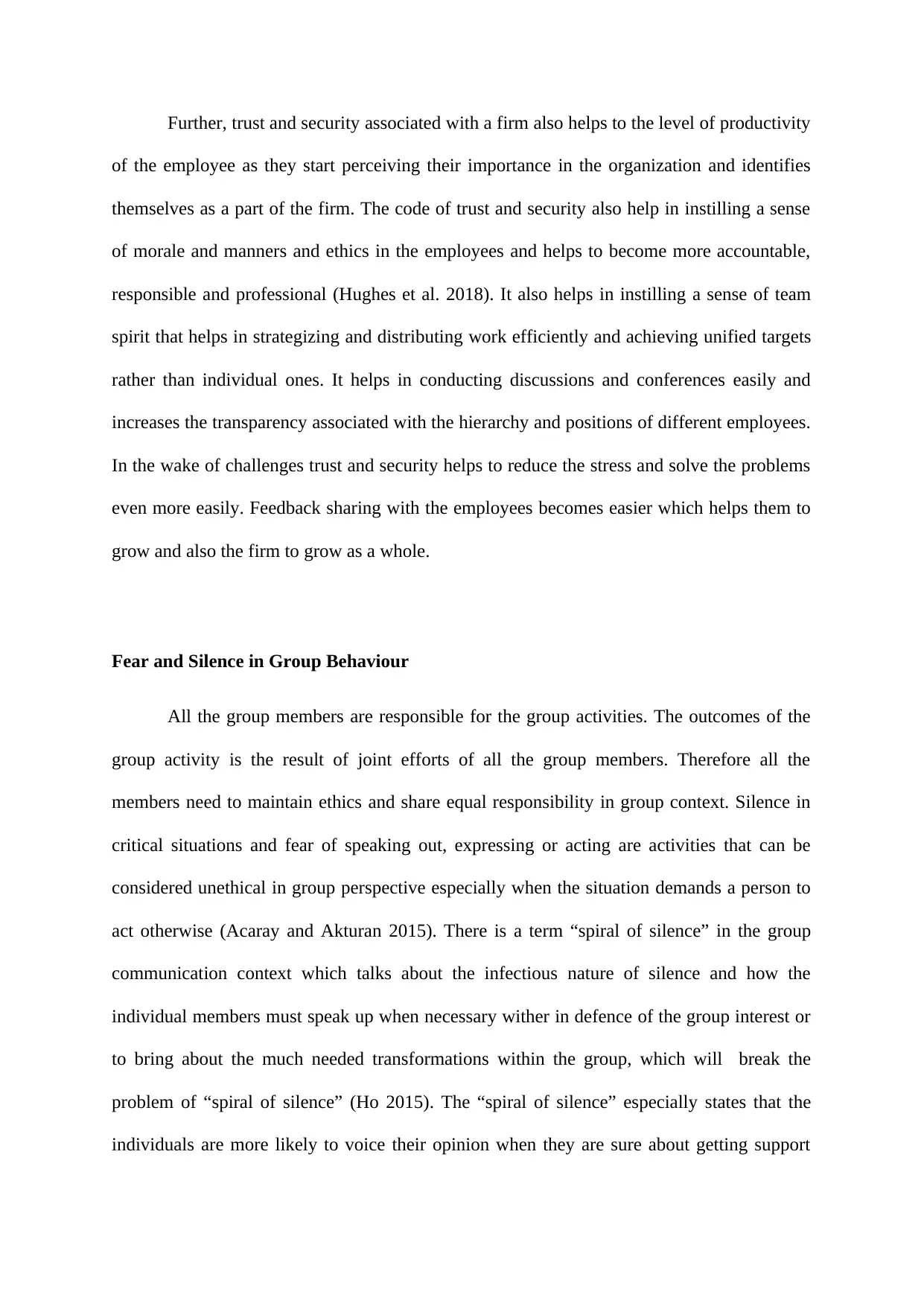
Further, trust and security associated with a firm also helps to the level of productivity
of the employee as they start perceiving their importance in the organization and identifies
themselves as a part of the firm. The code of trust and security also help in instilling a sense
of morale and manners and ethics in the employees and helps to become more accountable,
responsible and professional (Hughes et al. 2018). It also helps in instilling a sense of team
spirit that helps in strategizing and distributing work efficiently and achieving unified targets
rather than individual ones. It helps in conducting discussions and conferences easily and
increases the transparency associated with the hierarchy and positions of different employees.
In the wake of challenges trust and security helps to reduce the stress and solve the problems
even more easily. Feedback sharing with the employees becomes easier which helps them to
grow and also the firm to grow as a whole.
Fear and Silence in Group Behaviour
All the group members are responsible for the group activities. The outcomes of the
group activity is the result of joint efforts of all the group members. Therefore all the
members need to maintain ethics and share equal responsibility in group context. Silence in
critical situations and fear of speaking out, expressing or acting are activities that can be
considered unethical in group perspective especially when the situation demands a person to
act otherwise (Acaray and Akturan 2015). There is a term “spiral of silence” in the group
communication context which talks about the infectious nature of silence and how the
individual members must speak up when necessary wither in defence of the group interest or
to bring about the much needed transformations within the group, which will break the
problem of “spiral of silence” (Ho 2015). The “spiral of silence” especially states that the
individuals are more likely to voice their opinion when they are sure about getting support
of the employee as they start perceiving their importance in the organization and identifies
themselves as a part of the firm. The code of trust and security also help in instilling a sense
of morale and manners and ethics in the employees and helps to become more accountable,
responsible and professional (Hughes et al. 2018). It also helps in instilling a sense of team
spirit that helps in strategizing and distributing work efficiently and achieving unified targets
rather than individual ones. It helps in conducting discussions and conferences easily and
increases the transparency associated with the hierarchy and positions of different employees.
In the wake of challenges trust and security helps to reduce the stress and solve the problems
even more easily. Feedback sharing with the employees becomes easier which helps them to
grow and also the firm to grow as a whole.
Fear and Silence in Group Behaviour
All the group members are responsible for the group activities. The outcomes of the
group activity is the result of joint efforts of all the group members. Therefore all the
members need to maintain ethics and share equal responsibility in group context. Silence in
critical situations and fear of speaking out, expressing or acting are activities that can be
considered unethical in group perspective especially when the situation demands a person to
act otherwise (Acaray and Akturan 2015). There is a term “spiral of silence” in the group
communication context which talks about the infectious nature of silence and how the
individual members must speak up when necessary wither in defence of the group interest or
to bring about the much needed transformations within the group, which will break the
problem of “spiral of silence” (Ho 2015). The “spiral of silence” especially states that the
individuals are more likely to voice their opinion when they are sure about getting support
Paraphrase This Document
Need a fresh take? Get an instant paraphrase of this document with our AI Paraphraser

from other group members. Silence is driven by either fear or anger, and silence in crucial
times may harm the group interest greatly which is a harmful factor that may destroy the
anticipated outcomes, therefore these behaviours within the group is considered unethical and
needs resolution.
times may harm the group interest greatly which is a harmful factor that may destroy the
anticipated outcomes, therefore these behaviours within the group is considered unethical and
needs resolution.
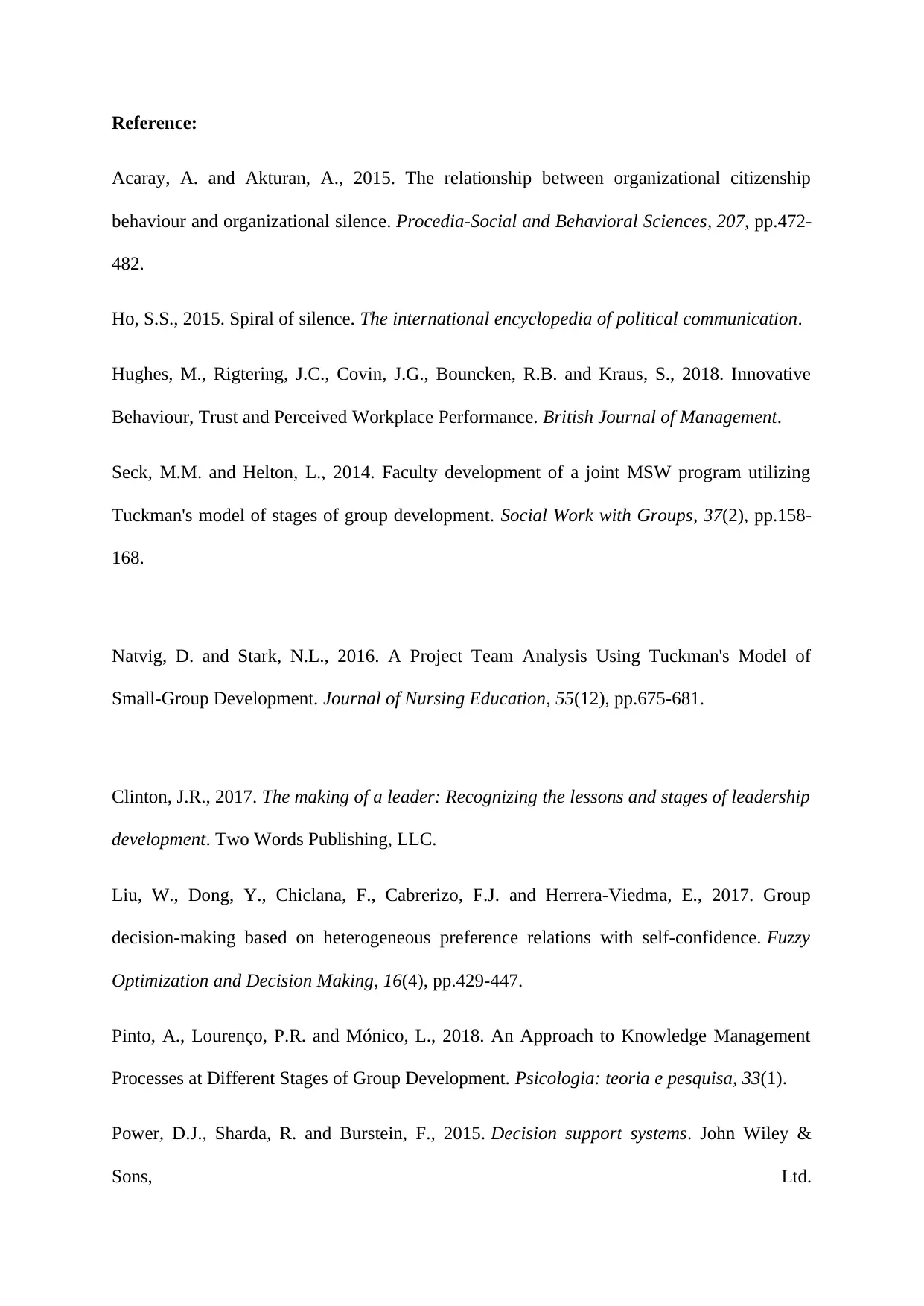
Reference:
Acaray, A. and Akturan, A., 2015. The relationship between organizational citizenship
behaviour and organizational silence. Procedia-Social and Behavioral Sciences, 207, pp.472-
482.
Ho, S.S., 2015. Spiral of silence. The international encyclopedia of political communication.
Hughes, M., Rigtering, J.C., Covin, J.G., Bouncken, R.B. and Kraus, S., 2018. Innovative
Behaviour, Trust and Perceived Workplace Performance. British Journal of Management.
Seck, M.M. and Helton, L., 2014. Faculty development of a joint MSW program utilizing
Tuckman's model of stages of group development. Social Work with Groups, 37(2), pp.158-
168.
Natvig, D. and Stark, N.L., 2016. A Project Team Analysis Using Tuckman's Model of
Small-Group Development. Journal of Nursing Education, 55(12), pp.675-681.
Clinton, J.R., 2017. The making of a leader: Recognizing the lessons and stages of leadership
development. Two Words Publishing, LLC.
Liu, W., Dong, Y., Chiclana, F., Cabrerizo, F.J. and Herrera-Viedma, E., 2017. Group
decision-making based on heterogeneous preference relations with self-confidence. Fuzzy
Optimization and Decision Making, 16(4), pp.429-447.
Pinto, A., Lourenço, P.R. and Mónico, L., 2018. An Approach to Knowledge Management
Processes at Different Stages of Group Development. Psicologia: teoria e pesquisa, 33(1).
Power, D.J., Sharda, R. and Burstein, F., 2015. Decision support systems. John Wiley &
Sons, Ltd.
Acaray, A. and Akturan, A., 2015. The relationship between organizational citizenship
behaviour and organizational silence. Procedia-Social and Behavioral Sciences, 207, pp.472-
482.
Ho, S.S., 2015. Spiral of silence. The international encyclopedia of political communication.
Hughes, M., Rigtering, J.C., Covin, J.G., Bouncken, R.B. and Kraus, S., 2018. Innovative
Behaviour, Trust and Perceived Workplace Performance. British Journal of Management.
Seck, M.M. and Helton, L., 2014. Faculty development of a joint MSW program utilizing
Tuckman's model of stages of group development. Social Work with Groups, 37(2), pp.158-
168.
Natvig, D. and Stark, N.L., 2016. A Project Team Analysis Using Tuckman's Model of
Small-Group Development. Journal of Nursing Education, 55(12), pp.675-681.
Clinton, J.R., 2017. The making of a leader: Recognizing the lessons and stages of leadership
development. Two Words Publishing, LLC.
Liu, W., Dong, Y., Chiclana, F., Cabrerizo, F.J. and Herrera-Viedma, E., 2017. Group
decision-making based on heterogeneous preference relations with self-confidence. Fuzzy
Optimization and Decision Making, 16(4), pp.429-447.
Pinto, A., Lourenço, P.R. and Mónico, L., 2018. An Approach to Knowledge Management
Processes at Different Stages of Group Development. Psicologia: teoria e pesquisa, 33(1).
Power, D.J., Sharda, R. and Burstein, F., 2015. Decision support systems. John Wiley &
Sons, Ltd.
⊘ This is a preview!⊘
Do you want full access?
Subscribe today to unlock all pages.

Trusted by 1+ million students worldwide

Palomares, I., Martinez, L. and Herrera, F., 2014. A consensus model to detect and manage
noncooperative behaviors in large-scale group decision making. IEEE Transactions on Fuzzy
Systems, 22(3), pp.516-530.
Raes, E., Kyndt, E., Decuyper, S., Van den Bossche, P. and Dochy, F., 2015. Group
development and team learning: How development stages affect team-level learning
behavior. Human Resource Development Quarterly.
Woodcock, M., 2017. The stages of team development. In Team Development Manual (pp.
29-36). Routledge.
noncooperative behaviors in large-scale group decision making. IEEE Transactions on Fuzzy
Systems, 22(3), pp.516-530.
Raes, E., Kyndt, E., Decuyper, S., Van den Bossche, P. and Dochy, F., 2015. Group
development and team learning: How development stages affect team-level learning
behavior. Human Resource Development Quarterly.
Woodcock, M., 2017. The stages of team development. In Team Development Manual (pp.
29-36). Routledge.
1 out of 10
Related Documents
Your All-in-One AI-Powered Toolkit for Academic Success.
+13062052269
info@desklib.com
Available 24*7 on WhatsApp / Email
![[object Object]](/_next/static/media/star-bottom.7253800d.svg)
Unlock your academic potential
Copyright © 2020–2025 A2Z Services. All Rights Reserved. Developed and managed by ZUCOL.





